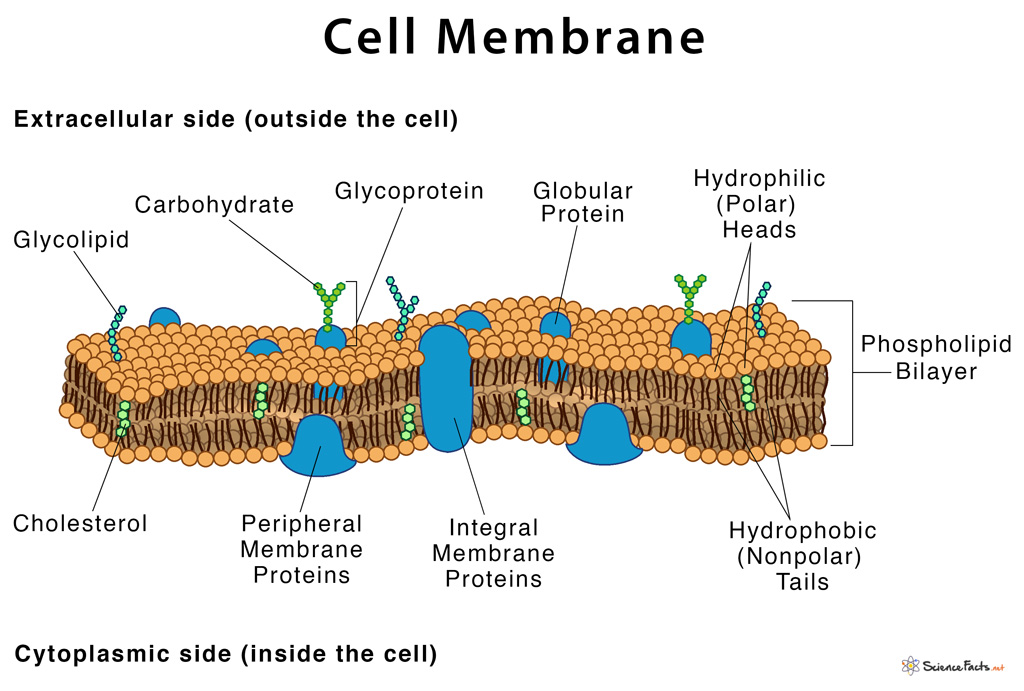Cell Membrane: Structure, Composition, and Functions
What is a Cell Membrane
The cell membrane, also called the plasma membrane, is a thin layer that surrounds the cytoplasm of all prokaryotic and eukaryotic cells, including plant and animal cells. It is a selectively permeable cell organelle,allowing certain substances inside the cell while preventing others to pass through and thus is analogous to a barrier or gatekeeper in their function. It also serves as the site of attachment for the cytoskeleton that helps to provide shape and support to the cell.
The most widely accepted model of the cell membrane was given by S.J. Singer and Garth L. Nicolson in 1972, popularly known as the fluid mosaic model.
Structure and Composition: What is the Cell Membrane Made Of
The main components that make up all cell membranes are lipids, proteins, and carbohydrates. Their proportions vary between different types of eukaryotic cells, but their basic characteristics remain the same. For a typical human cell, proteins account for about 50 percent of the composition by mass, lipids account for about 40 percent, and the remaining 10 percent comes from carbohydrate molecules. The arrangement of different proteins and lipids in the cell membrane looks like the arrangement found in a mosaic floor.
Described below are the three major parts along with their detailed make up:
1. Lipids
It is one of the main components of the cell membrane that makes up the cell’s structural framework. Membrane lipids are of the following types:
- Phospholipid: Major component of the cell membrane forming a bilayer structure. The hydrophilic (water-loving) head of phospholipids points towards the inner cytoplasmic side and outer extracellular fluid. While the hydrophobic (water-hating) tail faces away from them. Thislipid bilayer is semi-permeable, meaning that it allows only certain molecules to diffuse across the membrane.
- Cholesterol: Another lipid component of animal cell membranes that are selectively dispersed between phospholipid molecules. Cholesterol works by preventing phospholipids from being too closely packed thus preventing the cell membranefrom becoming stiff
2. Proteins
It is the second major part of the cell membrane. The two main categories of membrane proteins are:
- Integral Membrane Proteins: Also called intrinsic proteins, they are permanently embedded within the cell membrane. Structurally, the integral proteins are hydrophobic in nature that penetrates the phospholipid bilayer, thus anchoring the protein to the membrane.
- Peripheral Membrane Proteins: Also called extrinsic proteins, they are only temporarily associated with the membrane. Most peripheral membrane proteins are hydrophilic, so they are usually attached to integral membrane proteins or are loosely bound to the phospholipid head group. They help in cell signaling and are often associated with ion channels and transmembrane receptors.
3. Carbohydrates
It is the least abundant component of the cell membrane. Carbohydrates are found on the outside surface of cells that exists in either of the following two forms:
- Glycoproteins: Proteins having carbohydrate chains attached to them. They are embedded within the cell membrane and are important in cell-to-cell communications and transport of substances across the membrane.
- Glycolipids: Lipids having carbohydrate chains attached to them. They are located on the surface of the cell membrane, extending from the phospholipid bilayer into the extracellular environment. Glycolipids help to maintain membrane stability and to facilitate cellular recognition and cell-to-cell communication.
Functions: What Does the Cell Membrane Do
Primary Role
Selectively Permeable: Creates a potential gradient across the membrane that allows small uncharged molecules such as oxygen, carbon dioxide, and water as well as hydrophobic substances such as lipids to get through the membrane passively inside the cell without any loss of metabolic energy. While charged ions such as sodium, potassium, and calcium as well as large molecules like amino acid and carbohydrates cannot pass through. This is important for the cell to preserve its internal milieu irrespective of any environmental changes and thus is the main function of the cell membrane.
Other Purposes
- Protection and Cell Defense: Insulates the interior of the cell and provides mechanical support from outside shock and harmful agents
- Maintaining Homeostasis: Determines the internal milieu of the cell, the physiological conditions such as temperature and osmotic pressure by maintaining the salt balance
- Maintaining Concentration Gradient: Maintains the differences in concentration of substances inside and outside the cell thus helping in their transport
- Signal Transduction: Receives and processesthe extracellular signals by receptor molecules present in the cell membrane and relay them inside the cell for necessary actions
- Catalysis of Chemical Reactions: Stimulates chemical reactions that help in the growth and metabolism of the cell using enzymes
- Cell Communication: Allows exchange (receiving and sending) of messages between adjacent cellsthus helping them to function in a coordinated fashion
- Adaptation and Response: Helping to sense the extracellular environment and thus regulating the fluidity of the cell membranes by altering the lipid of the cell
- Maintaining Cell Shape and Morphology: Acting as the base of attachment for the cytoskeleton that helps in cell movement
FAQs
Ans. All living cells, including bacterial cells, have a cell membrane that helps in selective permeability of substances.
Ans. Viruses being non-cellular in origin do not have a cell membrane. In enveloped viruses an analogous structure called the envelope serves similar functions to a cell membrane.
-
References
Article was last reviewed on Thursday, February 2, 2023




